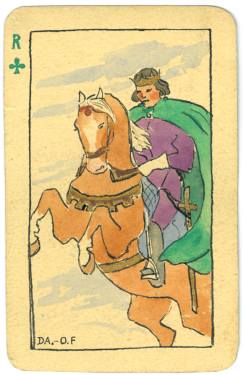 |
? D.A. - O.F. ? -1-
The large cards are shown at 200%, the small ones are shown at actual size. |
|
|
|
When a deck like this is offered to you, you don't hesitate if it's affordable. And as you can see.......... it happened to us and we didn't hesitate.
The dealer who offered us this deck at the flea market in Utrecht immediately apologized for the fact that there were 4 cards missing. But we had already spotted the fact that the aces and court cards were handmade watercolors, which made the deck a unique piece. Unfortunately the four missing cards were three courts and an ace, so we had to miss 4 small pieces of art. But the deck is such a good example of how an artist can create a unique work of art in a playing cards format, that we would like to share it with you here.
Each watercolor has been signed. It's remarkable that the signature on each of the present Kings reads "D.A. - O.F.", while the other court cards are signed "O.F."only. But that's only one of the intriguing things about this deck. Of course we would love to know where the initials stand for. The dealer said that he might be able to help us, but hasn't contacted us yet. Of course we've already begun searching the internet ourselves, but -as a long shot- we hope that one of our visitors here might come up with an answer.
 |
? D.A. - O.F. ? -1-
The large cards are shown at 200%, the small ones are shown at actual size. |
|
|
|
It must have been a professional artist or a talented amateur, as some of the artwork is magnificent: see the Jack of Spades above. We've magnified the King of Spades to show that the artist has not only used watercolours, but also a solid silver colour for the armours. On the Jack of Clubs some gold paint was used to highlight details, but gold doesn't show well on scans, so there was no use to magnify that card. The Queen of Clubs is the only card without an outline around the design and shows an unusual evening scene, in which a queen is sniffing a rose behind a curtained window.



Unfortunately the Queen of Diamonds is one of the missing cards. The designs of the other Queens makes you wonder if in the Diamonds suit she would also have been depicted in a window with 3 flowers beneath it, a theme which was also used on the Jack of Clubs.

Too bad that we don't know the name of the artist. That might have lead to determine the origin of the deck. Now we can only guess. The use of the French indices could point to a French origin, but also to a Walloon one. On the aces (see page 2) the letter "A" is used. In a true French deck this would have been the number "1", but there are French decks with an A on the aces too.


All 3 Kings present are on horses, so it's most likely that the King of Hearts was also depicted on a horse. As all the Kings here are signed D.A.-O.F. it's also likely that this signature can be found on the missing King too. And that makes you wonder about the D.A. addition. It must be something in the design that was done by this D.A. and my first thought was that maybe O.F. wasn't very good in drawing horses and had left that design to D.A. But then the D.A. should have been on the Jack of Diamonds too. It remains intriguing and we've run out of ideas here. Any suggestions????
See the next page for the aces, 4 pips and the back.